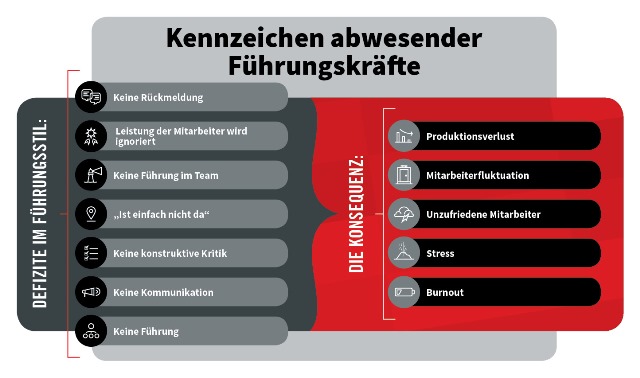Absenteeism: the silent killer of organizations
Those who are destructive are not those who go behind their colleagues' backs, mob or insult them - quite the opposite: it is those who do nothing at all. More and more studies show that an absent leadership style, also known as laissez-faire leadership, not only harms the workforce, but also results in measurable production and sales losses for the company concerned.

There's an old saying that goes, "Only those who shout the loudest are heard." In every organization, it is the case that those managers who do the most damage stand out clearly, whether in the form of development or disciplinary measures. Studies reveal however, that by far the most destructive leadership behavior goes completely unrecognized: the absentee leadership style.
Absenteeism harms
Absentee leaders may be physically present, but they offer no guidance to their subordinates. They are people who do not actively cause trouble; therefore, the damage they can do often goes unnoticed. Likewise, they do not receive the developmental programs necessary to change their thinking. According to the preliminary research of Hogan Assessments these leaders are considered extremely cautious and hesitant - characteristics that do not make the individual stand out from the crowd. Because absentee leaders are rarely conspicuous for grossly negligent behavior, they escape corrective action. As a result, their negative influence on organizations intensifies over time and it becomes increasingly difficult to counteract.
Unmotivated employees as an alarm signal
One of the strongest indicators of an absentee management style is unmotivated employees. If employees express dissatisfaction about their jobs, but there are no obvious management problems, absenteeism is probably the problem. In a Study from 2015 about employee complaints was found to be directly related to absentee leadership. Study participants reported a lack of recognition or constructive feedback, unclear expectations or directives, and complained that their supervisors spent too little time in direct dialogue with subordinates.
A Gallup study recently calculated that unmotivated employees cost the German economy 105 billion euros in productivity a year - 70 percent of those surveyed said they had no emotional attachment to their employer. One of the main reasons is a lack of feedback. In Germany, for example about 40 percent of employees want more feedback from their superiors, and the trend - especially among "Gen Y" - is rising.
Promoted employees must first learn leadership
Absentee leaders are ubiquitous in organizations. One of the main reasons is that companies generally find it difficult to identify good leaders. Employees are often promoted because they are not guilty of anything or because they are popular. However, being a good corporate citizen does not necessarily equate to good leadership. Moreover, promoted employees often do not know what leading means. They may be good at meeting the requirements of the position they were once hired for, but lack leadership skills or relevant experience. And finally, corporate culture also plays a certain role: feedback is often undervalued. After all, giving constructive feedback is something of an art. For fear of offending employees, many managers shy away from correcting behavior.
Risk factor absenteeism: Five consequences for organizations
In short, the greatest damage is done by those leaders who do not continue to stand out. The consequences of this can be:
- Unclearly defined tasks: Absentee managers fail to set goals for their team. This increases the risk for employees of Uncertaintywhat exactly is expected of them. As a consequence, a lot of energy is spent on defining one's own area of responsibility instead of acting in a goal-oriented manner.
- Low job satisfaction: Lack of feedback from an absent supervisor can make employees feel undervalued or unsure of their role. Low job satisfaction is directly related to declining productivity and thus noticeable losses for companies.
- Health problems: The stress caused by absentee executives manifests itself in an increased number of those who have resigned internally. The health consequences are manifold: anxiety disorders and depression, high blood pressure and gastrointestinal disorders are frequently observed.
- Burnout: One Gallup poll According to the study, unclearly defined tasks and a lack of communication and support from superiors are among the main causes of burnout syndromes. In the absence of a clear leadership style, employees are overly burdened. The consequences are growing exhaustion and cynicism.
- Churn trends: The most common reason to change employers is poor leadership. One Study on destructive leadership behavior according to the study, workers were twice as likely to struggle with absentee leaders than with other forms of poor leadership.
Recognizing leadership competence in employees
Scott Gregory, CEO of Hogan Assessments, has been studying absentee leadership for nearly 30 years. He says, "Even though the impact on employees is well known, there are few organizations that systematically identify absent leaders and take appropriate action. There's a good chance your organization hasn't even identified absent leaders yet, because they're usually below the perception threshold and behaving inconspicuously." Using objective performance measures, such as personality tests, such latent behavioral traits can be detected. Scott Gregory: "If your organization has one of the relatively few is with effective selection and promotion methods, there is a possibility that effective and destructive leaders will be identified."
Source and further information: www.hoganassessments.com









